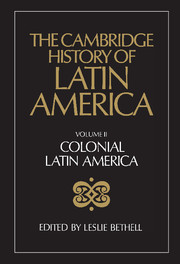Book contents
- Frontmatter
- PART ONE POPULATION
- PART TWO ECONOMIC AND SOCIAL STRUCTURES: SPANISH AMERICA
- PART THREE ECONOMIC AND SOCIAL STRUCTURES: BRAZIL
- PART FOUR INTELLECTUAL AND CULTURAL LIFE
- 16 Literature and intellectual life in colonial Spanish America
- 17 The architecture and art of colonial Spanish America
- 18 The architecture and art of colonial Brazil
- 19 The music of colonial Spanish America
- Bibliographical essays
17 - The architecture and art of colonial Spanish America
from PART FOUR - INTELLECTUAL AND CULTURAL LIFE
Published online by Cambridge University Press: 28 March 2008
- Frontmatter
- PART ONE POPULATION
- PART TWO ECONOMIC AND SOCIAL STRUCTURES: SPANISH AMERICA
- PART THREE ECONOMIC AND SOCIAL STRUCTURES: BRAZIL
- PART FOUR INTELLECTUAL AND CULTURAL LIFE
- 16 Literature and intellectual life in colonial Spanish America
- 17 The architecture and art of colonial Spanish America
- 18 The architecture and art of colonial Brazil
- 19 The music of colonial Spanish America
- Bibliographical essays
Summary
This chapter is divided geographically into two broad regions: first Mexico, Central America, and the Caribbean; then the rest of Spanish America, that is Spanish South America. Within each we shall look at architecture, sculpture, and painting. The emphasis will be on architecture, especially religious architecture, together with the quasi-architectural retables (a kind of ‘fantasy architecture’). In the fields of sculpture and painting we shall encounter some distinguished artists and even some series of significant works which, with some difficulty, might be deemed to constitute a ‘school’, such as the Quito school in sculpture and the Cuzco school in painting. But only in the field of architecture do we find any coherence and continuity. It is therefore to architecture that we must look for the key to an understanding of the culture of colonial Spanish America.
Ninety per cent of what is interesting in Spanish colonial architecture falls into the category of religious architecture. Important cities possessed a cathedral plus a smaller or greater number of parish churches in the hands of the secular clergy. Belonging to the regular clergy of the religious orders, besides the convents themselves were the churches and chapels that depended upon them, known as conventuales. ‘Religious’ architecture, however, consisted not only of cathedrals, churches, and chapels but also hospitals, colleges, universities, and other institutions which in colonial society were the responsibility of the church, as well as estate and mission buildings. And as the financial resources of the church grew, its wealth was expressed in the increasing size and splendour of its buildings.
- Type
- Chapter
- Information
- The Cambridge History of Latin America , pp. 709 - 746Publisher: Cambridge University PressPrint publication year: 1984



